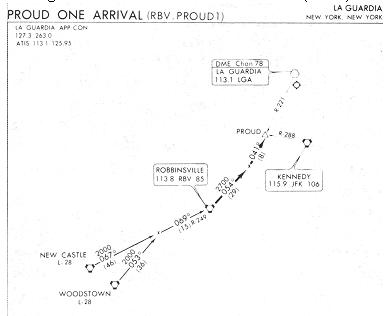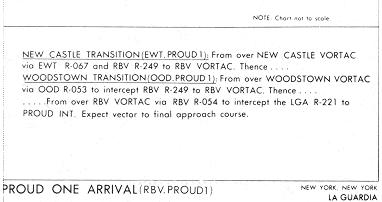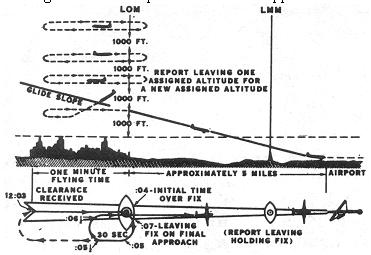

ATC arrival procedures and your cockpit workload are affected by weather conditions, traffic density, aircraft equipment, and radar availability.
Standard Terminal Arrival Routes (STARs). These routes have been established to simplify clearance delivery procedures for arriving aircraft at certain areas having high density traffic. A STAR (Fig. 12-3) serves a purpose parallel to that of a SID for departing traffic. You should remember the following points regarding STARs:
Figure 12-3. Standard terminal arrival route (STAR).
 |
|
 |
1. All STARs are contained in one booklet which is published
every 56 days with each issue of the National Ocean Survey Approach and
Enroute Charts. The descriptions are both graphic and textual. The AIRMAN'S
INFORMATION MANUAL describes STAR procedures.
2. Pilots of IFR civil aircraft destined to locations for which
STARs have been published may be issued a clearance containing a STAR whenever
ATC deems it appropriate. The use of a STAR requires pilot possession of
at least the approved textual description.
3. It is your responsibility to either accept or refuse an issued
STAR. If you do not wish to use a STAR, you should advise ATC by placing
"NO STAR" in the remarks section of your filed flight plan or by the less
desirable method of verbally advising ATC.
4. If you accept a STAR in your clearance, you must comply with
it, just as you comply with other ATC instructions.
Uncontrolled Airports (No Tower). On a flight in an uncongested area into an airport with no tower, the controlling ARTCC advises you to contact the Flight Service Station at or near the destination airport for airport advisory information. This includes the current local altimeter setting, wind direction and velocity, runway information, and known traffic. Further reports are relayed by Flight Service to the Center until you have canceled your IFR flight plan.
Airports With Tower. Your workload can be much greater on arrival at a terminal area where a combination of low ceiling and visibility, heavy traffic, and type of available approach aids requires considerable delay in the issuance of approach clearances. At an airport equipped with ILS facilities, the local controllers can normally handle an arrival every 2 minutes. At the same airport, with the ILS system unavailable and the VORTAC located 8 miles from the field, the arrival interval may be increased to 10 minutes.
Whatever the reasons for delaying instrument approaches - including arrival intervals, traffic density, deteriorating weather, missed approaches, etc., - holding may be necessary. The order of priority of issuance of approach clearances is normally established on a first-come-first-served basis. The first aircraft estimated over the fixes from which approaches are begun will be the first to receive an approach clearance, followed by the aircraft in the order of their estimated or actual times of arrival over the several fixes.
Holding. "Holding" is maneuvering an aircraft along a predetermined flight path within prescribed airspace limits with respect to a geographic fix. The fix may be identified visually (without reference to instruments) as a specified location, or by reference to instruments as a radio facility or intersection of courses. VORs, radio beacons, and airway intersections are used as holding points.
The diagram in Figure 12-4 illustrates control procedures used when a number of aircraft are stacked at an approach fix (Outer Compass Locator) on an ILS front course, with additional aircraft holding in the stack at an outer fix (VOR). Successive arriving aircraft are cleared to the approach fix until the highest altitude/flight level to be assigned is occupied, and thereafter to the outer fix at an appropriate altitude/flight level above the highest level occupied at the approach fix. This permits aircraft subsequently cleared to the approach fix to proceed in descending flight. The illustration shows an interval of 2 minutes between successive approaches. The #1 and #2 aircraft have already passed the Outer Locator (LOM) on final approach, and the #3 aircraft has been cleared for approach and to depart the LOM 2 minutes after the #2 aircraft reported leaving the LOM inbound on final approach.
Figure 12-4. ATC procedures - timed approaches.
 |
As Figure 12-4 shows, to fly a holding pattern involves a combination
of simple basic maneuvers - two turns and two legs in straight-and-level
flight or descending when cleared by ATC. Although these maneuvers are
far less difficult than, for example, absolute-rate climbs or descent to
predetermined headings and altitudes (see Chapter V, "Attitude Instrument
Flying - Airplanes"), holding procedures are a common source of confusion
and apprehension among instrument pilot trainees.
There are many reasons for this apprehension, among them the
idea that holding implies uncertainty, delay, procedural complications,
and generally an increased workload at a time when you are already busy
reviewing the details of your instrument approach. Another reason involves
the normal psychological pressure attending approach to your destination,
when you become increasingly conscious of the fact that your margin of
error is narrowing. The closer you get to touchdown, the more decisions
you must make, and the decisions must be quick, positive, and accurate
as you have fewer chances to correct the inaccuracies. Like any other flight
problem, holding complications become routine after sufficient study of
the procedures in their normal sequence.
Standard Holding Pattern (No Wind). At or below 14,000 feet, the standard holding pattern (Fig. 12-5) is a racetrack pattern requiring approximately 4 minutes to execute. The aircraft follows the specified course inbound to the holding fix, turns 180° to the right, flies a parallel straight course outbound for one minute, turns 180° to the right, and flies the inbound course to the fix.
Figure 12-5. Standard holding pattern - no wind.
 |
Nonstandard Holding Pattern. A nonstandard holding pattern is one in which the fix end and outbound turns are made to the left. Your ATC clearance will always specify left turns when a non-standard pattern is to be flown.
Standard Holding Pattern With Wind. In compliance with the holding
pattern procedures given in the AIRMAN'S INFORMATION MANUAL, the symmetrical
racetrack pattern cannot be tracked when a wind exists. Pilots are expected
to -
a. Execute all turns during entry to and while in the holding
pattern at 3° per second, or a 30° bank angle, or a 25° bank
angle if a flight director system is used; whichever requires the least
bank angle.
b. Compensate for the effect of a known wind except when turning.
Figure 12-6 illustrates the holding track followed with a left
crosswind. Further details of compensation for wind effect are given in
this manual in Chapter VIII, "Using the Navigation Instruments - Tracking."
The effect of wind is thus counteracted by correcting for drift on the inbound and outbound legs, and by applying time allowances to be discussed under "Time Factors."
Holding Instructions. If you arrive at your clearance limit before receiving clearance beyond the fix, ATC expects you to maintain the last assigned altitude and begin holding in accordance with the depicted holding pattern. If no holding pattern is depicted, you are expected to begin holding in a standard holding pattern on the course on which you approached the fix. You should immediately request further clearance. Normally, when no delay is anticipated, ATC will issue holding instructions at least 5 minutes before you estimated arrival at the fix. Where a holding pattern is not depicted, the "General Holding Instructions" in the AIRMAN'S INFORMATION MANUAL state that the ATC clearance will specify the following:
Figure 12-6. Drift correction in holding pattern.
 |
1. Direction of holding from the fix, using magnetic directions
and referring to one of eight general points of the compass (north, northeast,
east, etc).
2. Name of the holding fix.
3. Radial, course, magnetic bearing, airway number or
jet route on which holding is to be accomplished.
4. Outbound leg in nautical miles if DME is used.
5. Left turns, if nonstandard pattern is to be used.
6. Time to expect further clearance (EFC), or time to
expect approach clearance (EAC).
Suitable ATC instructions will also be issued whenever -
1. It is determined that delay will exceed 1 hour.
2. A revised EFC or EAC is necessary.
3. In a terminal area having a number of navigation aids
and approach procedures, a clearance limit may not indicate clearly which
approach procedures will be used. On initial contact, on as soon as possible
thereafter, approach control will advise you of the type of approach you
may anticipate.
4. Ceiling and/or visibility is reported as being at or
below the highest "circling minimums" established for the airport concerned.
ATC will transmit a report of current weather conditions, and subsequent
changes, as necessary.
5. Aircraft are holding while awaiting approach clearance,
and pilots thereof advise that reported weather conditions are below minimums
applicable to their operation. In this event, ATC will issue suitable instructions
to aircraft which desire either to continue holding while awaiting weather
improvement or proceed to another airport.
Standard Entry Procedures. The entry procedures given in the Airman's Information Manual evolved from extensive experimentation under a wide range of operational conditions. The standardized procedures should be followed to ensure that you remain within the boundaries of the prescribed holding airspace.
You are expected to reduce airspeed to holding speed 3 minutes prior to your ETA at the holding fix. The purpose of the speed reduction is to prevent overshooting the holding airspace limits, especially at locations where adjacent holding patterns are close together. The EXACT time at which you reduce speed is not important, so long as you arrive AT THE FIX at your preselected holding speed within 3 minutes of your submitted ETA. If it takes more than 3 minutes for you to complete a speed reduction and ready yourself for identification of the fix, adjustment of navigation and communications equipment, entry to the pattern, and reporting, make the necessary time allowance.
Technique will vary with pilot experience, cockpit workload, aircraft performance, equipment used, and other factors. With dual VOR receivers, dual transceivers, distance measuring equipment, Integrated Flight System (Flight Director), autopilot, and a copilot to share the workload, holding is far less of a problem than it would be for an inexperienced solo pilot holding with a single obsolescent VOR receiver.
Refer to Enroute - IFR in the Airman's Information Manual for a discussion of holding pattern entries, turns, and airspeeds.